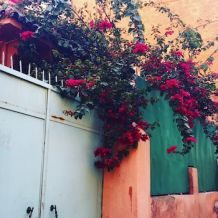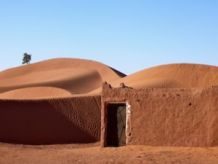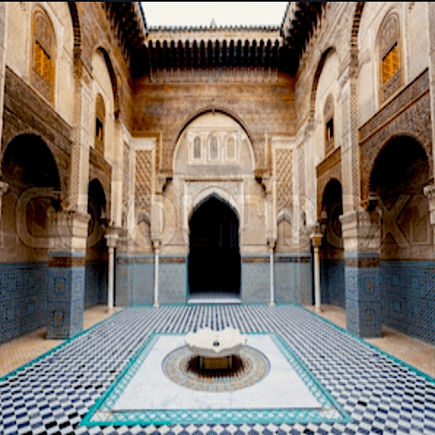
Islamic geometric design mixes elements of math, art, and history. During your trip through Morocco, you will see colorful geometric patterns on mosques, madrasas, palaces, and private homes. Within these contexts, beautiful patterns can be discovered on kilim carpets, zellige tilework, walls, fountains, pillars, the trimmings of front doors, furniture decor, ceilings, stairways, halls, courtyards, and gardens,. Many travelers arriving in Morocco admire the abstract designs yet feel perplexed about the origins and meaning behind the Islamic patterns. As a result, we created a guide to help you understand abstract art and put it into context. You may also want to consider the Al Attarine Madrasa. Fes Islamic geometric design mixes elements of math, art, and history. During your trip through Morocco, you will see colorful geometric patterns on mosques, madrasas, palaces, and private homes. Within these contexts, beautiful patterns can be discovered on kilim carpets, zellige tilework, walls, fountains, pillars, the trimmings of front doors, furniture decor, ceilings, stairways, halls, courtyards, and gardens,. Many travelers arriving in Morocco admire the abstract designs yet feel perplexed about the origins and meaning behind the Islamic patterns. As a result, we created a guide to help you understand abstract art and put it into context.
Past & Present of Islamic Geometric Art
Historically, Islamic patterns emerged around the 7th century, when craftsmen borrowed designs from the Persian and Roman cultures and adapted them as ornamental decoration in places of Islamic worship. In religious spaces, Islamic art does not represent religious figures as seen in idolatry but instead uses shapes and figures in repetitive patterns and calligraphy to inspire prayer. The abstract repetitions got especially popular during the 8th century Islamic Golden age, a period marked by major achievements in math and science. Sophisticated geometric patterns like floral and vegetal motifs were seen repeating endlessly on carpets, textiles, and tiles designs.
In the twenty-first century, these patterns have taken on new energy in Moroccan interior design. In Morocco’s medinas, geometric patterns can be found in architectural details, shops, and fashion. Riads are renovated and use tilework known as zellige on stairways, wall fountains, interior courtyard floors, walls, and as design accents; ceilings are vaulted and coffered with cedar.
Tessellation: Arrangement of Patterns
Many Islamic designs are arranged in beautiful patterns called tessellations. There are three common shapes that can form regular tessellations: the equilateral triangle, square, and regular hexagon. Any one of these three shapes can be duplicated infinitely to fill a plane with no gaps. Everything starts with a circle that can be drawn with a compass and split into parts with a ruler. How it is split however will determine the style and design. Most circles are split into 4,5, or 6 equal sections. Each division stylizes the pattern. You can determine if the design is based on 4, 5, or 6 fold symmetry by finding the star in the center of the tile and counting the number of rays and petals around it. A star surrounded by 6 rays belongs in the 6 fold category, a star with 8 petals will have 4 rays and it belongs to the 4 fold category.
Tessellation is based on mathematical elegance. Regardless of how elaborate the designs look, they are always based on hand-drawn grids. Furthermore, Islamic design is based on Greek geometry which has a fundamental belief that complexity can be achieved with simple tools.
Beyond Islamic architecture, tessellation can be found in everyday goods: oriental carpets, quilts, origami, Islamic architecture, and the artwork of M. C. Escher, who made tessellations with irregular interlocking tiles in the shape of animals and natural objects.
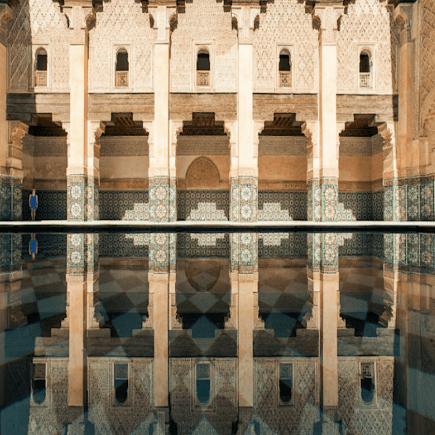
Islamic Patterns & Astronomy
An interesting fact that most people overlook when studying Islamic patterns is that there is an abundance of stars. Many researchers on Islamic culture and architecture believe there may be a symbolic link to the star shapes and astronomy. Morocco is a Muslim country with a call to prayer five times a day, stars are believed to exist as to provide the direction to Mecca; star gazing acts like a compass. Muslim cultures are also home to nomadic tribes who live in remote mountainous regions and also the Sahara Desert, therefore star navigation has an important skill.
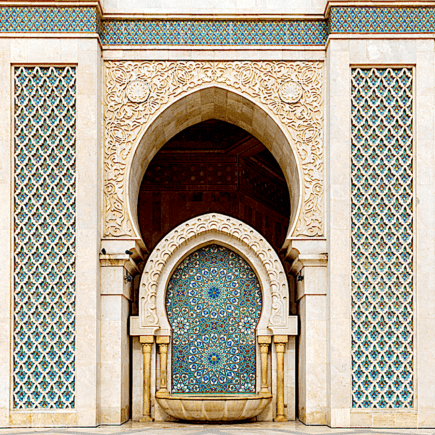
Discover Star Patterns: Benches, Fountains, Walls, Moroccan Zellige Tiles
Another common pattern you will observe in Morocco is in the form of a zellige tile. Zellige, handcrafted glazed terracotta tiles made from natural clay from the Fes region, and Meknes are used throughout Morocco. The tiles are revered for their high quality, color, traditional craftsmanship. Historically, zellige first flourished in Andalucia when the Moors took over parts of Southern Spain. Later the technique was developed during the Nasrid, Merinid, and Zayyanid dynasties. The 14th century introduced blue, green, and yellow colors to zellige, and red was added in the 17th century; old enamels with the natural colors were used until the beginning of the 20th century. The glass enamel tiles are best characterized by variations of tone, shine, flatness, transparency, and depth of the glazing. No tile is exactly the same. Zellige tiles come in many shapes, sizes, and compositions. They are often found in riads, private residences, bench parks, fountains, walls, or floor installations.
Discover Patterns: Medersa Bou Inania, Fes; Bab Mansour, Meknes; Place El-Hedine, Meknes, Mellah, Casablanca
Arabesques
Arabesque patterns are best described as flowing lines of branches, leaves, and scroll-work that are elegantly intertwined. There are two common modes of arabesque art. In the first mode, each repeating geometric form has a built-in symbolism. For example, the square, with its four equilateral sides, is symbolic of the elements of nature: earth, air, fire, and water. The second mode is based upon the flowing nature of plant forms. This mode recalls the feminine nature of life-giving. In addition, upon inspection of the many examples of Arabesque art, some would argue that there is, in fact, a third mode, the mode of Islamic calligraphy. Arabesque patterns can also be found in artistic printing like book covers, page decorations, calligraphy.
Discover Patterns: Saadian Tombs, Marrakech; Kourin Mosque University, Fes; Hassan II Mosque, Casablanca, Mausoleum of Mohammed V, Rabat
Muqarnas sometimes referred to as honeycomb vaulting, can best be described as ornamental vaulting. The purpose of the Muqarnas is to create a visually smooth transition between straight walls and domed room. The elaborate design is often found in coffered ceilings, half domes, niches, arches, iwans, and upper corners of a square room. Muqarnas is constructed from plaster and wood or bricks covered in plaster or ceramic clay.
For more information about Islamic Design or a Marrakech Design Tour


